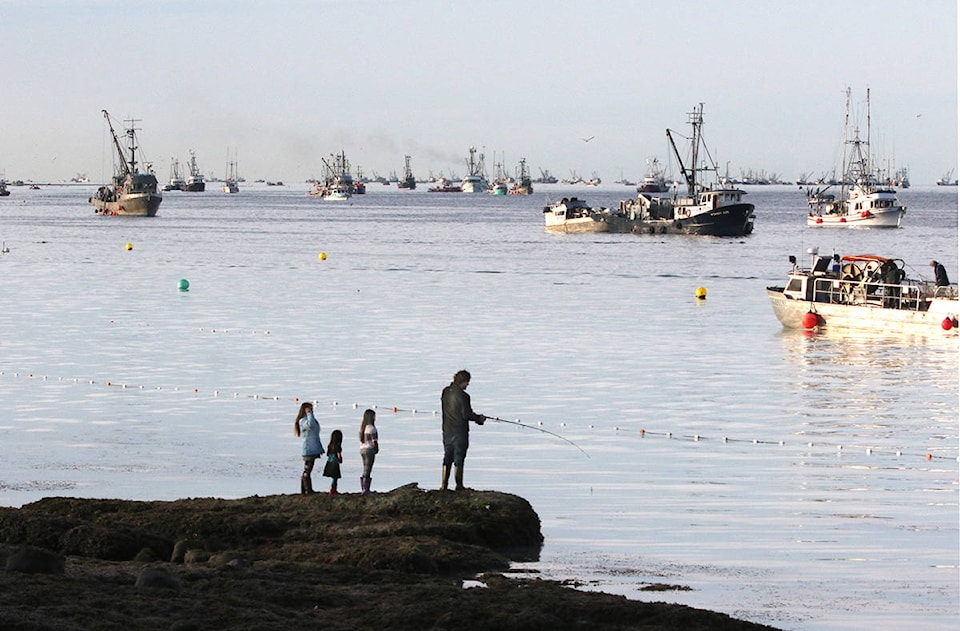The case for the Strait of Georgia roe herring fishery
Comox fisherman, Quincy Sample, was laying on the deck of his boat under the warm March sun, waiting for the waves to die down when reached by phone. The fishery opened for gill nets on March 15 in the Strait of Georgia, and Sample was hoping for the right conditions to get his net in the water.
Sample has worked on the ocean for the majority of his life. Growing up on the Sunshine Coast, he started fishing when he was 16, and now, 30 years later, fishing is what supports his family of five.
“It’s not a predictable industry,” he said from his boat, a 30-foot-long aluminum herring skip.
The weather is something that fishermen have to deal with no matter the fishery, but with herring, timing is crucial. Not only does the water have to be relatively calm, the fishermen need to catch the female herring before they have spawned, but when their eggs are at maturity.
“We want to make sure we harvest them when it’s worth the most, otherwise you’re wasting a good resource,” said Sample.
Used to opposition
Throughout his career, Sample has heard every argument against the fishery, but he remains confident the herring stock is being managed properly and sustainably.
He said fishermen are not trying to take every last fish out of the ocean – how could they continue to fish and support their families if that were their goal?
“[Herring are] at high numbers now and we’re taking our quota – only up to 20 per cent,” he said. “But when the fish don’t show up and there’s not enough fish, we don’t fish to that number. We don’t take more.”
According to the Department of Fisheries and Oceans, the herring stocks are at “historically high” levels based on their data that dates back to 1951.
“Do I think that we’re going to over-fish the area to the point where they’re not going to come back? Not one bit,” continued Sample.
The herring fishery takes place at a time of year when no other fisheries are open in the Strait of Georgia, making it an important source of income for many in the industry, including fishermen and plant workers.
| advocating for the final B.C. herring fishery to be shut down. However, he also hopes to increase employment insurance weeks for industry workers who would be affected by a fishery shut down. But for Sample, who needs the income to support his family, he calls this a “slap in the face.” “If you’re making $800 to $1,000 a ton and your quota is 140 tons – you do the math, that’s a lot of money,” he said. “An extra EI cheque, that would be a slap in the face. That’s nothing. When he would talk about increasing that as a viable option to shutting the fishery down, it’s ridiculous.” Throughout his 30 years participating in the fishery, Sample said he has probably invested around $250,000 just to get out on the water to work. There’s the cost of the boat, netting, maintenance, but also the costs of the fishing licences themselves. This year, Sample bought four of his own licences and leases another 11. Each licence allows the catch of 9.6 tons of herring. The total allowable catch for this year in the Strait of Georgia – 20 per cent of the total estimated population – is around 21,000 tons of herring, split evenly between seiners and gillnetters. Fishery based on scienceThough Greg Thomas has never been a roe herring fisherman himself, he has worked with the federal government and the industry in various capacities. Previously a fishery manager for the Department of Fisheries and Oceans, he is now the executive director of the Herring Conservation and Research Society. The HCRS is funded by members of the B.C. herring fishery, and contributes to researching, managing and assessing the herring on the west coast of B.C. The organization works with DFO to ensure the herring stock is well managed and harvested at sustainable levels. Annually, the industry contributes around $1.5 million to studying herring along the B.C. coast. While much of the harvested roe is sold to Japanese markets, according to Thomas, the fishery brings in an average of $40 million to the B.C. economy annually. According to Thomas, in the Strait of Georgia, the number of herring in the area has been fairly consistent for the last few years and is well above the limit reference point – the absolute minimum population level. “The issue with herring populations is they’re highly dynamic, they go up and down rapidly over time and they live off of periodic strong recruitment, so new fish coming into the population,” said Thomas. “In the Strait of Georgia, the recruitments have been quite strong.” In other areas where the fisheries have been shut down, Thomas says the dwindling numbers have been due to environmental conditions, not a defect of fishing.
|
